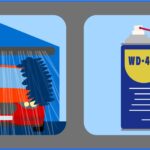Dealing with a flat tyre can be a frustrating experience for any driver. A common question that arises when faced with a puncture is, “can you repair a tubeless car tyre?”. Understanding the limitations and safe practices of tyre repair is crucial for ensuring your safety and the longevity of your tyres. This article delves into the guidelines for tubeless car tyre repair, focusing on where repairs are permissible and why sidewall damage is a critical concern.
Tyre repair policies, like ours at Car Repair Online, are often aligned with safety standards such as the British Standard BSAU159. This standard clearly defines the area considered safe for minor repairs on a tyre. Specifically, only punctures located within the central ¾ of the tyre tread, known as the minor repair area, are eligible for repair. If a puncture occurs outside this zone, especially closer to the sidewall, repair becomes problematic and is generally not recommended. Even a slow puncture in this outer area is considered too risky for a safe and durable minor repair.
The crucial question then becomes: why is the sidewall of a tyre irreparable? The tyre sidewall is engineered to handle significant stress and load as the tyre rotates and bears the vehicle’s weight. When a minor puncture is repaired, the damaged area undergoes preparation using an air drill to create a clean surface for the repair patch. While this process is perfectly safe within the minor repair area, applying it to the sidewall introduces a potential risk of weakening the tyre’s structural integrity.
Furthermore, the sidewall experiences the greatest degree of flexing during normal tyre operation. This constant movement makes a repair patch applied to the sidewall highly susceptible to detachment. The increased flexing in this area means that a repair is far less likely to hold, potentially leading to rapid deflation or even tyre failure while driving, compromising safety.
Given that the sidewall is outside the designated minor repair area, it’s paramount to avoid driving on a flat tyre unless you are using run-flat tyres designed for this purpose. Driving on a deflated tyre can severely compromise its repairability, even if the initial puncture was within the repairable central zone. Without air pressure, the tyre sidewall gets pinched between the wheel rim and the road surface. This pinching action causes significant and often irreparable damage to the sidewall. Consequently, even if your puncture started in the minor repairable area, driving on a flat tyre may inflict secondary sidewall damage, rendering the entire tyre unrepairable.
In conclusion, while tubeless car tyres can be repaired, the location of the puncture is the deciding factor. Repairs are safely limited to the central ¾ of the tyre tread, away from the sidewall. Sidewall punctures are not repairable due to safety concerns related to structural integrity and flexing. To maximize the chances of a successful repair and ensure your safety, it is essential to address punctures promptly and avoid driving on flat tyres, protecting the vulnerable sidewall from damage.

